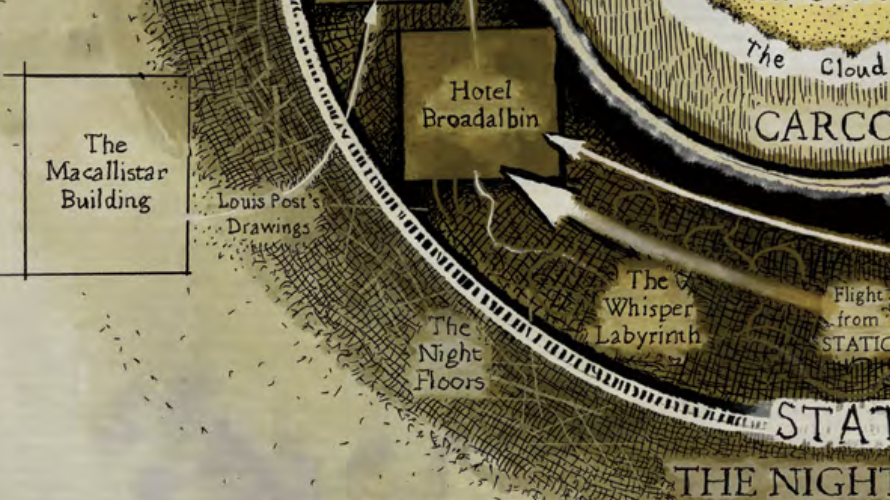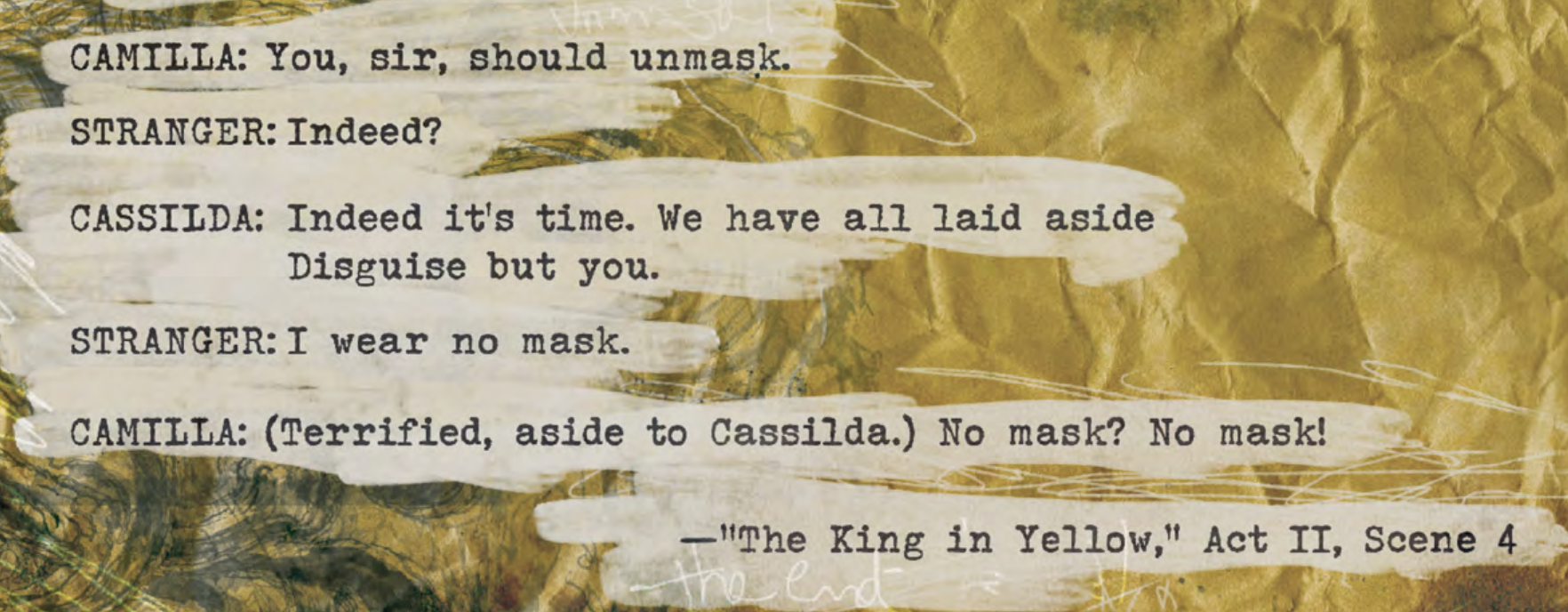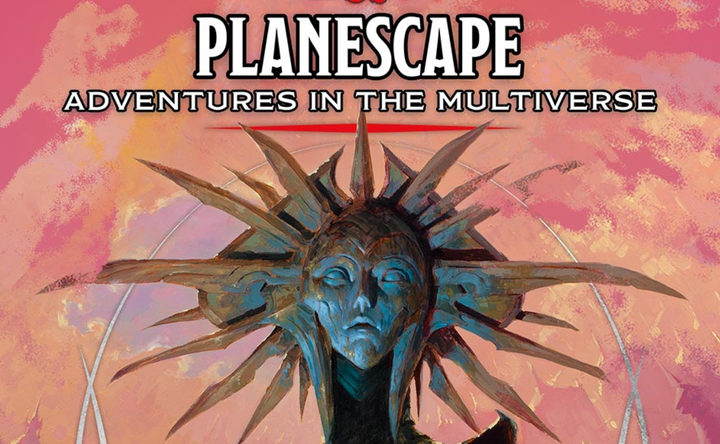On the Impossibility of Landscapes
Impossible Landscapes is a large-scale campaign for the Delta Green role-playing game, written by Dennis Detwiller and published in 2021. This article is a short history of Carcosan roleplay, a review of said campaign, a manifesto, and a project announcement all bundled together.

Impossible Landscapes is a large-scale campaign for the Delta Green role-playing game, written by Dennis Detwiller and published in 2021. Delta Green is a game of desperate, broken operatives combating Lovecraftian horrors in a contemporary setting—Call of Cthulhu meets X-Files, but grittier and less forgiving, somehow. Impossible Landscapes attempts to present a long-running campaign set against the horror of Robert Chambers rather than H.P. Lovecraft: the horror of reality collapsing around itself, being unable to trust your senses, of delusion, delirium, and despair. The centerpiece of any Chambersian horror is a mysterious play entitled The King in Yellow (or some variation thereof), which presents us a masquerade ball held in the dying hours of a doomed city. In the play, a royal court awaits the coming of a whispered-of true king, the King in Yellow, and the king’s arrival signals the wholesale collapse, in a literal sense, of their world. The city in which the play transpires is subsumed and replaced in reality by Carcosa, a landscape connected with the king. A “Phantom of Truth”, herald of this King, channels Edgar Allan Poe and informs a horrified crowd of partygoers toward the end of the masquerade that he cannot unmask, his “Pallid Mask” which they assumed to be an unsettling disguise is no mask at all. I read this as a metaphor for lifting the veil on the false sensory overlay and perceiving the askew world contaminated by the Yellow King. Once you’ve seen the Yellow Sign, you can’t remove the mask: you can only see “delusive reality.”

Moreover, exposure to the play triggers the gradual decay of logic and reality in the world around those exposed. They become unwitting conduits of the Yellow King, helping it manifest in our world, and begin, ineluctably, to act as harbingers of madness and despair themselves. The play generates an advanced type of Stendhal Syndrome—viewing Carcosan art causes a form of mental destabilization, which leads to causal entropy slowly taking over the world around the viewer; order being only, on this read, a thin overlay imposed on the “true” or Carcosan world, which exists without order. Carcosa subsumes all.
To do this sort of horror at the gaming table is, needless to say, tricky. You can’t fight entropy with guns. You can barely reason about delusion. For this to work, the player characters themselves must simultaneously be possible conduits of The King and, in order to keep the action moving, they must be able to “do something about” it. Tricky.
Impossible Landscapes, to its credit, boldly attempts to square this circle. I am not sure it succeeds.
At this point I should mention that I am not a Delta Green aficionado; this is in fact the only Delta Green text I have read outside of the QuickStart guide. I am an aficionado of Robert Chambers! I have run several large-scale Lovecraftian campaigns and always injected them with Chambersian touches. The King in Yellow and Nyarlathotep are the twin pillars of my cosmic horror cosmos, if you will.
Let’s dig in and look directly at these landscapes.
ACT I — Visions Of Lost Carcosa

There are a few general directions that games have taken The King in Yellow. The more traditional stream derives from August Derleth’s later efforts to “systematize” the Lovecraftian Mythos (Lovecraft was super into Robert Chambers’ stories.) These efforts mostly miss the point, in my opinion: they retain the play, the madness, but grant the Yellow King a name, Hastur, and place “him” as one of many Great Old Ones in a great cosmic org chart beyond man’s ken. This sort of reduces The Yellow King to “just another Lovecraftian ancient evil”, with cults dedicated to bringing him and/or Carcosa to earth for nefarious purposes. Maybe your characters meet and even fight this weird baroque King, in his famously tattered robes. The cult is more art-flavored and they have different uniforms than other cults. You’re gonna go to an insane asylum for sure. We see this in Tatters of the King (Chaosium, 2006) — a serviceable application of the Call of Cthulhu Globetrotting Fight Against The Mythos™ formula. Same for a whole slate of stand-alones produced for Call of Cthulhu or its derivatives, and plenty of light-RPG boardgames take this tack.
I want to shout out John Wick (the game designer, not the fictional international man of assassination) for his collection called Curse of the Yellow Sign (2009) which presents a compelling fusion cuisine. The three scenarios presented in CotYS are truly excellent, disturbing looks at various forms of mental breakdown after exposure to The King in Yellow. They also heavily feature a supernatural Nyarlathotep-ian entity that exists to tempt humanity forward towards Carcosa in a way that I hadn’t seen before. These scenarios don’t so much try to channel Chambers’ ideas as reinterpret them and give the GM the opportunity to take on a more active, participatory role as this avatar, persuading the characters to embrace the King.[[0]]

I should also mention the Arkham Horror Card Game’s campaign cycle called The Path to Carcosa (2017) here as well. This is a very successful hybridization of the Globetrotting Dark Adventure strain that adds Chambersian narrative elements: the party’s attitude towards their own mental health in the form of doubt and conviction are tracked, and events can be perceived in completely different lights depending on how they are approached; these narrative elements let the game have its Dark Pulp Adventure framework while eating its delusional cake, if you will. It also introduces a memorably challenging scenario where the party enters an insane asylum as investigators only to find reality shifting around them as they become patients that have to break free. This is a major plot element in the second act of Impossible Landscapes as well.
But what these approaches do not have going for them is that surreal and delusional sense of reality gone awry that pervades Chambers’ work. They’re too mechanically locked-in to their traditional form. To break free of that, we sort of need a new approach.
There are really just two options that I know of: The Yellow King RPG by Robin Laws (Pelgrane Press, 2020) and these Impossible Landscapes. YKRPG presents a series of four campaign frames that have all been touched by the corrosive force of Carcosa and the King in Yellow. Each frame is set in a different time and place, presenting a different way to inject all the creepy and mysterious corners of the world with whispers of The King. The settings provide advice for how to play each frame with characters that “echo” each other and therefore suggest that each is a sort of alternate timeline; it also discusses how one might connect the two bookend frames together, providing a through-line that ties each of the frames together thematically (and perhaps literally, as Carcosan delusive reality bleeds in.) There isn’t a written campaign in here, but instead advice for how to write your own.
This is actually something that everything else we’ve mentioned has lacked: it is the one resource on this list that tries to grapple with how to present reality horror and the infiltration of Carcosa into our world in a game setting. To that end, it provides a lot of possible “operating theories” about what’s going on with the play, the characters in it, what they might do as they are brought into contact with our world, what visiting their world might be like, and so on. It doesn’t provide fully concrete answers—suggesting instead that you pick the answers you need when you need them at the table. That you might, with a twinkle in your eye, change them later in response to what your players do.
It sounds paradoxical, but laying out a list of possible operating theories for an all consuming madness really is the best help a GM could have when trying to tackle Chambers. Having such a set of theories is the only way the players are going to be able to engage satisfactorily with the campaign. The dearth of such advice in Impossible Landscapes is something of a surprise, but it does reference one of the seminal works of the genre.
ACT II - Landscapes, Unmasked
I was delighted to read in the prologue that the Impossible Landscapes campaign owes much to John Tynes’ seminal article The Road to Hali [[1]] (The Unspeakable Oath #1, 1990), which I think is the definitive starting point for imagining how to incorporate “Carcosa” (and in particular a trip to Carcosa) into one’s tabletop game. And indeed, much of Impossible Landscapes’ handling of the climactic visit to Carcosa is drawn directly from that article. Strange and wondrous locations: the Whisper Labyrinth, the Gallery of Shades, the cloud-filled depths of Hali with their secret… all present and accounted for.

After this prologue, an extremely detailed timeline of (Delta Green’s version of) the infiltration of the King in Yellow into our world unfurls. It is dense, packed with names and dates—first an outbreak in medieval France, then the classic Chambersian stuff, then some hay about a criminally insane architect in the 1910s-20s both in Chicago and New York; a skip forward to New York in the 1950s as Delta Green tries—and fails, ultimately—to contain several rapid-fire efforts to stage the play, and then finally to 1995. Teams of operatives and a hearty crew of those unfortunates drawn into the Carcosan orbit are detailed. It is daunting and complex—and used mostly as a recurring through-line of paranoia as people, places, and things are shown to share dates and places “coincidentally” with significant backstory events. There is a thorough discussion of tone and style, highlighting well the differences between this sort of horror and the more traditional Lovecraftinalia. A new mechanic is introduced, Corruption, measuring an agent’s level of Carcosan contamination—Corruption is never truly good but higher scores unlock surreal-er doors in the forthcoming adventures.
The graphic design of the book is top notch and high quality. The text design channels House of Leaves, which is neat. There are shedloads of accompanying props, of really great quality. The text layout and organization, however, is physically difficult to follow. Large sections of the text are broken up by very large parenthetical sections with different art design; often you’ll have to skip forward or backward by multiple pages in order to follow the thread of a section. You’ll frequently have to skip around to the introductory material to follow a timeline reference, or back to the end of a chapter to find out more about an NPC. Encounters are listed in what I suspect is “playtest order”—antagonist reactions are in-lined with investigative scenes, and the flow of investigative scenes is presented in a particular linear pattern rather than organized topically or thematically.

I only want to talk in general terms about the adventure structure; I’ll try not to spoil details or major twists—but there are mild spoilers starting now! There are four acts and three “interstitial” scenes. The campaign begins in 1995, with a missing persons investigation in New York City—“The Night Floors”—which introduces a recurring motif: day/night differences in a Carcosa-infested location; nighttime being dangerous, where the location offers access to a liminal space full of terrifying swiss-cheese passagework that separates our world from that of the Yellow King. Notably, the team cannot resolve the case; they can only survive, and be ushered forward in time to “A Volume of Secret Faces”, to the bizarre Carcosan-terminator-railroad of “Like a Map Made of Skin”, and through to Carcosa itself in “The End of the World of the End”. Between these latter two is a mandatory, very long and very interesting interstitial segment set in a vanished building, the “Hotel Broadalbin.” It is not clear to me why the hotel is presented as the “interstitial” scene rather than “Like a Map Made of Skin,” which is superficially a much weaker chapter.
"The Night Floors" is a tremendous introductory chapter; with a wide-ranging and tension-ratcheting investigation revealing a surreal alternate reality full of connections to other times, places, and NPCs. But it doesn’t really let the investigators dig in too much to those others. They’re pushed forward and through; their objectives erased in the face of surreality.
The theme of being pushed forward without resolution is constant throughout. As the text itself says: “the only way out is through.” At no point does a potential investigative party obtain something akin to agency within the plot. The agent’s task is mostly escape from horror and survival. And the campaign does not expect them to be doing much surviving: there are frequent sidebars on how to bring in new characters. The campaign establishes no through-line of NPCs or villains accessible in a meaningful way to the agents—it is puzzling to me how difficult it is for the agents to interact with these NPCs. The ultimate destination of the story, if played adroitly, is a wonderful twist that would be truly superlative if the pipework had been laid for it at all. And even getting to that ending is uncertain, at best.
There are brilliant scenes here: a smorgasbord of delightful Carcosan insanity. Heck, there is a table in here that provides ghastly revelations indexed to “Clown Height,” man! Inspiration overflows. Charged hints, shocking glimpses, and frightful whispers abound as the backstory wafts through, but what really stood out to me is that potential player parties have precious little opportunity to engage with this rich tapestry. It seemed like something that happened to them rather than with them. That might well be some folks’ jam. It would make for great TV, and I bet there’s a kick-ass Actual Play from a group[[2]] that can get into it as written out there.

But it’s not my jam. For as much as Impossible Landscapes gets right—it doesn’t reduce The King in Yellow to Lovecraftian Mythos God #12; it eschews traditional cultists altogether; it is maximally inventive with horror tropes—this campaign’s answers to “what do the player characters do around here” is ultimately all wrong for me.
ACT III — Masquerade Etiquette
Let me drop a couple of my touchstones here, so we know what I mean when I say that “what the player characters do” doesn’t line up with my GM principles. These are personal preferences; what moves me might not move you!
A character’s descent (or ascent?) into Carcosan madness ought to provide the cornerstone emotional experience for a Chambersian game. Watching reality crumble, and then possibly putting it back together, is one hell of an arc. That arc is weakened if characters are replaced constantly, as this campaign clearly envisions. The first time your character is driven insane by exposure to the whatever for the mythos takes? That should be a Big Damn Moment. Especially, especially in this sort of game it doesn’t have to be the end. Hell, that character is awake to the machinations of the King now. If you’re on your third character? It’s just more GM %$^kery. I just don’t hold with this underlying assumption that appears present here—and in a lot of older-school Call of Cthulhu modules, for that matter—that characters are disposable; what matters is getting to the end. What I want to do is take the character for “the ride”, not the player.

For me, scenes are the cornerstone of a game, and character interaction is the cornerstone of a scene. The very first thing I do when working on a campaign is to figure out the villains. If I can’t come up with compelling villains, the campaign is a pass from me. Characters ought to develop long-term relationships with interesting and persistent NPCs, and the players have to be able to develop an understanding—or at least a working theory—about the opposition and threats they face.[[3]] I had high hopes for Abigail and any number of the big backstory NPCs here, but they are all figments, floating in the fog. Glimpsed, but rarely do they share a scene. The only one who wants something from the agents is Abigail, and she can only be interacted with once, at the end of all things. Further, I expected that the agents would engage with the rich and detailed backstory outlined at the top of the campaign. Perhaps crossing paths with previous Delta Green teams from the past in a more substantial and interesting way? Instead of this, though, no matter what the agents investigate, plan for, or discover, all roads lead to some of the most brutal and direct railroading I’ve ever read.
This doesn’t mean what's here is ineffective, mind you. Things can be effective without being my jam. But what I can’t shake is the feeling that if the agents were to develop relationships with these NPCs and feel able to theorize about the nature of Carcosa, they’d confidently begin to explore the Night World and find their own way to Hotel Broadalbin willingly. That, to me, is the basis of a more powerful narrative.
Lastly, it is my belief that characters ought to be interacting with the core premise of “the unspeakable horror” from the drop in a horror game, and again as often as possible. Even if they don't know it yet. For me, the King in Yellow represents entropy—not just of physical processes, but of mental ones, of causation and temporality. Once we’ve introduced a backstory that sprawls across time and extends all the way to infinite horizons in Carcosa, I want more than one single forward jump of 20 years. I want jumps and disjoint realities that echo into each other in defiance of time’s arrow. I do love the “Corruption” mechanic that is introduced—it does a great job modulating physical reality for each character. But I think I would want to cast the characters, or their echoes, around key moments in the text’s past. They should be digging into the Night World in meatier ways. In doing so, they’d interact with the NPCs more, they’d experience thundering simulacra of the King’s approach, and the finality of what they’ve done when they finally meet with Abigail (again) would pay off richly. I don’t want the backstory to be exposition—the past here shouldn’t be prologue, it should be the agents’ future.

This must also be said: there is, puzzlingly for a game that came out in 2021, very little discussion of player safety, what type of horror content is found where, and no discussion on how to route around thorny issues that will undoubtedly arise at the table. Perhaps such is not Delta Green play culture; for a campaign such as this which incorporates an astonishingly wide range of potential triggers, TPK deathtraps, brutally hard GM moves, and truly horrifying jump-scares, I found its absence surprising. There are dozens of scenes which will prove legitimately upsetting if not handled with care. Content warnings and player safety aren’t means to “water down” an experience for “lightweights.” They exist so a game can be enjoyed on terms that minimize disregulation and provide an open door to positive experiences for a wider pool of participants.
ACT IIII — The End of the Text of the End
Phew. That all sounds negative! I’m sorry. I didn’t want it to be; this really is one of the best King in Yellow campaigns I’ve ever read. The Night Floors, as an intro, is an especially inspiring and solid foundation to build on.

It might be that Delta Green just isn’t my kind of role-playing game, and that it doesn’t place the same weight on narrative agency, characters, NPC relationships, and so on that I do. Perhaps I should stick to (modern reinterpretations of) Call of Cthulhu. Fair! But I have read many posts on the internet from groups that have abandoned this campaign, despite its promise, because the text as written didn’t connect with them for some combination of the above reasons. This is a campaign text that prospective GMs and groups will have to do a lot of work on, and that’s honestly OK. It does strike me as a really good starting point for such work. The best campaigns I’ve run required a lot of work, and I do have the sense that this is such a campaign. These landscapes are impossible—but strangely compelling—as written.[[4]]
To that end, I think that this will be an excellent through-line for a project I’ve thought about doing for a while: I often see GMs ask “how do you prep a big, complex campaign?” Well, this sucker is as big, complex, and thorny as they come! I’d like to use this as a vehicle to invite you, dear reader, along for the ride as I dig way into this thing and build it back up into something I’d run… to show you how I’d take a crack at making the Impossible Landscapes possible.
[[0]]: These scenarios are also really dark. The player characters themselves take on the roles of antagonists.
[[1]]: This is now somewhat difficult to find online! I am told that there is a Delta Green supplement with an expanded version of the article.
[[2]]: I have since found the Glass Cannon Network's "Get in the Trunk" podcast, which started a playthrough of Impossible Landscapes in season 4. They are very good! I'm only partway in.
[[3]]: In the absence of relationships with key NPCs and a working theory of what's going on, it is going to be difficult for players to find their character's action. If they can't figure that out, then they are necessarily more passive participants that I'd like in our collaborative storytelling fun.
[[4]]: Again: for me. YMMV.



Comments ()